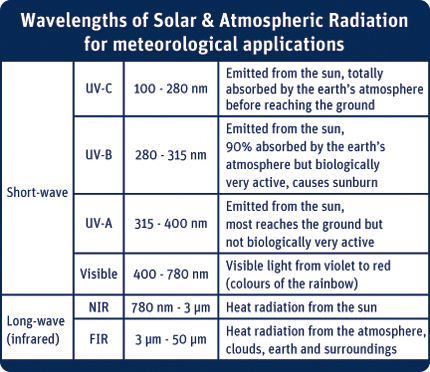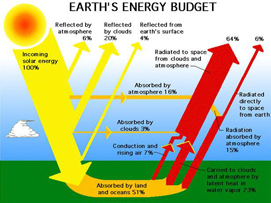Solar Radiation
Click here to first read more about the sun, the atmosphere and the Earth.
The sun is sending us radiation over a wide range of wavelengths at varying intensities. The electro-magnetic solar radiation impinging on the upper edge of the atmosphere is called extra-terrestrial radiation. The mean integral for the complete spectrum is 1,367 W/m² (the Solar Constant).
The normal measurement of the wavelength of solar and atmospheric radiation is the nanometer (nm, 10-9 m) and for infrared radiation is the micrometer (µm, 10-6 m). The range is shown in below table. In astronomy and older books you may see wavelengths in Ångström (Å, 10-10 m).

The meteorologically significant spectral range extends from 300nm to 3000nm (short-wave radiation). Approximately 96% of the complete extra-terrestrial radiation is situated within this spectral range. The maximum radiation intensity of the solar spectrum occurs at 500 nm, towards the blue end of the visible range.
The complete spectrum comprises the ultraviolet (UV), visible (Vis) and infrared (IR) wavelengths. However, these wavelength ranges need to be sub-divided depending on the individual application fields. Best known are the prismatic colours of visible light, the colours of the rainbow. IR is split into near infrared (NIR) and far infrared (FIR).
UV is normally sub-divided into UV-A, UV-B and UV-C radiation. Approximately 6% of the total solar radiation falling on the earth is ultraviolet. Shorter wavelengths (higher frequency) have higher energy, thus increasing the effect on biological and chemical systems.
The attenuation of solar radiation passing through our atmosphere is due to the following processes:
ultraviolet range
Scattering by molecules and aerosol particles and absorption by Ozone, Sulphur Dioxide, Nitrogen Dioxide and trace gases.
visible range
Scattering by molecules and aerosol particles, little absorption by aerosol particles, Ozone and other trace gases.
infrared range
Absorption by water vapour and aerosol particles but little scattering.
Molecular Ozone in the upper layers of our atmosphere functions as a filter for ultraviolet radiation and the effect increases with shorter wavelengths. Whereas almost all UV-A radiation reaches the ground surface, nearly 90% of the UV-B radiation is absorbed by the Ozone, and all of the UV-C. During this process, new Ozone (O³) is also produced from atmospheric Oxygen and this reinforces the process.
Changes of the atmospheric Ozone content will especially affect the amount of UV-B. An increasing Ozone layer concentration means decreasing UV-B radiation and a decreasing Ozone layer means increasing UV-B radiation reaching the surface.
Solar radiation is the driver for many chemical, biological and physical phenomena in the atmosphere, on the ground and in the seas.
A major effect of solar radiation reaching the earth’s surface is that it is warming it up, which is vital for our existence. 30% of the extra-terrestrial radiation solar radiation (yellow in Illustration below) is reflected back into space but approximately 51% is absorbed by land and water and another 19% is absorbed by the clouds and atmosphere.

Long-wave far infrared radiation (FIR) is shown in red and is mostly transformed short-wave energy that is re-radiated from the land, water, clouds and atmosphere. Only a small amount of the total energy remains on the earth but this is enough to maintain all the biological processes on our planet and to drive the weather systems.
Variations in the reflected and re-radiated energy do, of course, influence the energy balance between ground and atmosphere. This energy balance, in turn, influences meteorological conditions and other processes, for example the growth of plants.
Rising concern for the survival of our environment and way of life, together with the desire for higher crop yields, makes it necessary to have available precise information on incoming and reflected radiation. In this respect the distribution of the radiation intensity at different wavelengths can be of the utmost importance.
Nowadays, measuring solar radiation is extremely important in many different fields of application, such as climatology, meteorology, hydrology, pollution forecasting, solar energy, agriculture and material testing.
Source: Solar Radiation Measurement by Reinhold Rösemann
Read more about the parameters of meteorology.